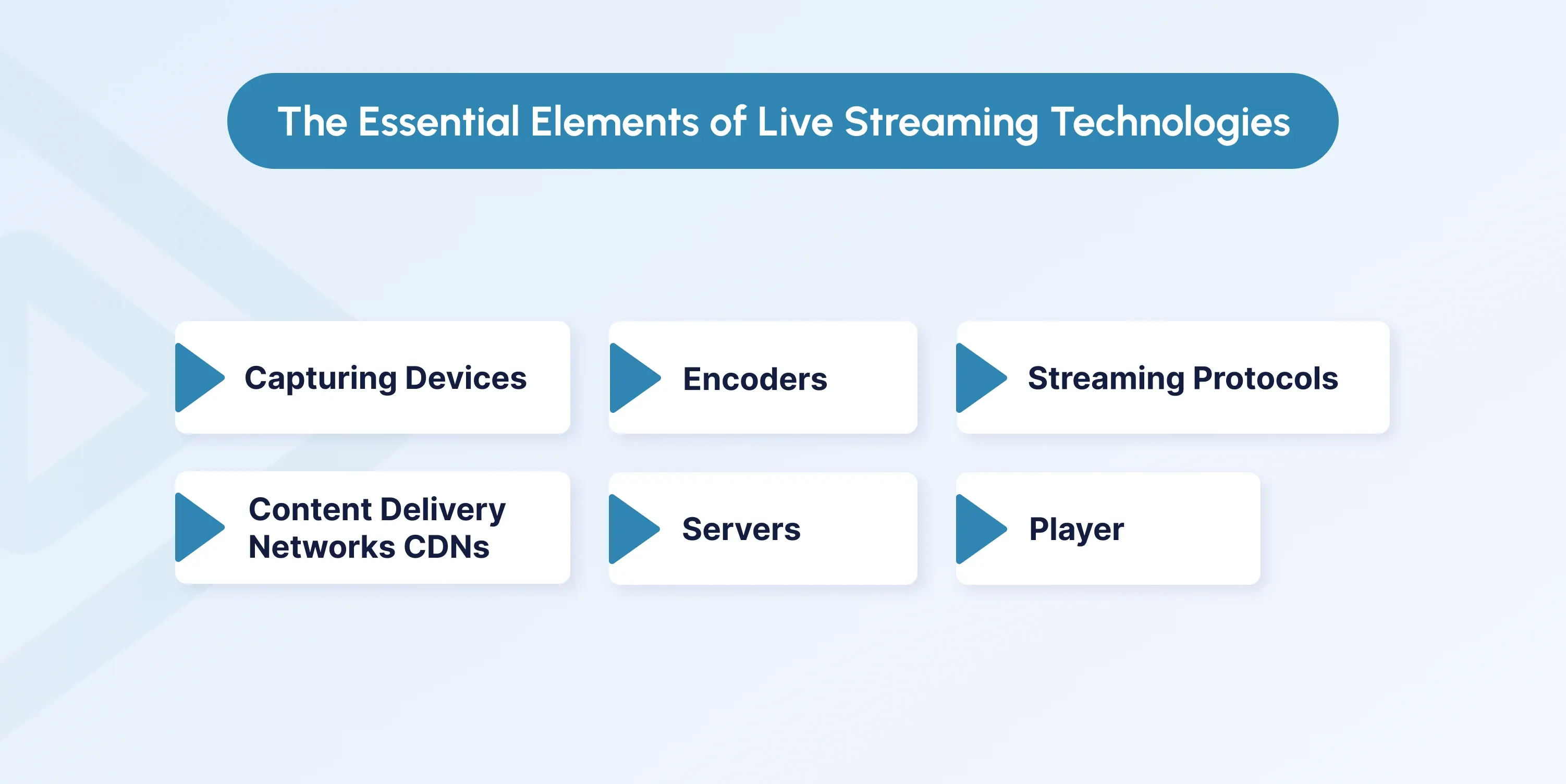
Live Streaming Technology: How It Works and Why It Matters
Live streaming technology allows you to produce highly customized content. This technology enables you to connect with diverse audiences across the globe, ultimately expanding your consumer base and enhancing your brand's reach.
In this article, we explore the definition of live streaming, the various live stream technologies available, and the significance of live streaming infrastructure.

Key Takeaways
- Live video streaming technology allows you to share real-time audio and video, enhancing audience engagement and experience.
- A robust live streaming setup requires essential equipment like encoders and servers to create seamless and captivating content.
- Utilizing live streaming data enables you to make quick adjustments, fostering more engaging content and facilitating real-time feedback.
- You can connect with diverse audiences worldwide, embracing various cultures and perspectives.
What is Live Streaming?
Live streaming is a method of sharing video content in real time on the Internet without extensive editing. Depending on the platform and audience, you can share pre-recorded and edited content through a live streaming service.
The use of live streaming technology has expanded into sectors like education, e-commerce, and professional communication-especially post-COVID-19.
Users appreciate the interactivity that live streaming technology facilitates, primarily through tools like live chat.
These features enable viewers to engage with others in the community, share their thoughts, and provide real-time feedback, helping you understand your audience better and refine your content.
Platforms like YouTube, Twitch, and Facebook Live have popularized live stream technologies, empowering content creators to interact more meaningfully with their viewers.
Notably, many Twitch channels have reported an impressive 16% increase in viewership, showcasing the growing impact of live streaming technology in the digital landscape.
Key Components of Live Streaming Technology
To truly grasp what live streaming is and how it works, we need to break down the key components of the live streaming infrastructure.
 Here’s a closer look at the essential elements:
Here’s a closer look at the essential elements:
Capturing Devices
First and foremost, you’ll need capturing devices to record your content effectively. This can include high-quality cameras, microphones, and proper lighting to enhance your live stream. A good-quality microphone is crucial for fostering personal interactions with your viewers, enabling you to build a stronger connection that can lead to a more loyal fanbase and support your content creation journey.
Encoders
What is live streaming without encoding? An encoder converts your raw video and audio into a digital format. Whether you choose a physical device or a software application, encoders allow you to compress your video for online sharing while maintaining quality. This is a fundamental step in the live streaming setup.
Streaming Protocols
How does live streaming work? The simplest answer is through streaming protocols. After your encoder converts your video and audio data into digital format, you need streaming protocols to transfer this data from the encoder to your server. Various protocols exist, each with its advantages and complexities, so finding the right one for your streaming needs is essential.
Commonly used protocols include:
- Real-Time Messaging Protocol (RTMP)
- HTTP Live Streaming (HLS)
- Web Real-Time Communication (WebRTC)
These are some commonly used video streaming protocols that can help you in live streaming.
Content Delivery Networks CDNs
Content Delivery Networks (CDNs) facilitate global sharing of your live stream. CDNs enhance your streaming experience by minimizing buffering and lagging, ensuring smoother playback for viewers across different locations.
Servers
Streaming servers are critical in distributing your content from encoders to CDNs. These servers enable seamless content sharing, providing your audience an enhanced viewing experience. This shared experience is key to building a strong community around your content.
Player
Finally, the player is the interface through which your audience watches your streams. Popular platforms like Twitch, YouTube, and Facebook Live exemplify effective player designs. These players allow viewers to play, pause, and engage in real-time chats with fellow community members, fostering a shared viewing experience that enhances audience interaction.
Types of Live Streaming Platforms
To understand live streaming technology, it’s essential to explore the various types of platforms available, tailored to different audiences and purposes.
Social Media
Social media platforms like Facebook, Instagram, and TikTok have embraced live streaming technology, allowing users to share real-time updates with their followers. These platforms facilitate more interactive content, making viewers feel more connected to their personal lives and helping them appear more relatable. You foster a sense of community and loyalty by engaging with your audience in this manner.
Live streaming
YouTube and Twitch are prominent platforms for sharing content among diverse audiences. Each platform offers unique features suited to different content types. For instance, Twitch is primarily designed for live streaming, making it ideal for showcasing gaming skills or other talents to a live audience.
One study indicated that Twitch users have consumed over 54 million hours of content, highlighting its popularity for real-time engagement.
In contrast, YouTube serves as an excellent repository for video-on-demand (VOD), allowing viewers to watch your content at their convenience. Different platform
In addition to social and dedicated streaming platforms, several applications are designed for professional use. Platforms like Zoom and Vimeo facilitate group meetings and webinars, offering features that enable easier interaction and collaboration among participants. These tools are particularly valuable for businesses and organizations leveraging live streaming technology for communication and training purposes.
Benefits of Live Streaming Technology
Reach
One of the most significant advantages of live streaming technology is its ability to transcend geographic barriers. You can engage a global audience, fostering a shared experience that cultivates connections among diverse cultures and communities. This broad reach allows you to expand your influence and create a more inclusive environment for your viewers.
Connection
Live streaming technology facilitates real-time interaction with your audience, resulting in a more personalized and immersive experience. This engagement helps you tailor your content to better meet your viewers’ preferences, leading to higher levels of satisfaction and loyalty. By utilizing features like live chat, you can foster a sense of community that enhances the overall viewing experience.
The Price
Compared to traditional forms of content creation, live streaming technology is remarkably cost-effective. With just a good-quality microphone and camera, you can kickstart your content creation journey. This affordability makes live streaming an attractive option for newcomers and those on a tight budget, allowing more creators to share their stories without significant financial investment.
Real-Time Data
Live streaming data offers valuable insights that can help inform your content strategy. By analyzing viewer interactions and preferences during your streams, you can make data-driven decisions that enhance your streaming experience and better cater to your audience's desires. Revenue
As your channel grows, so do your revenue opportunities. Over time, you can monetize your content through advertisements, subscriptions, and viewer donations. This potential for income generation makes live streaming technology not just a creative outlet but also a viable career path for many content creators.
Enhance Live Streaming With inoRain
inoRain provides solutions offering you high-quality services for your individual streaming needs.
By leveraging the live streaming data collected through our customizable platform, you can refine your streams and craft engaging content that resonates with your audience. This data-driven approach not only helps you understand viewer preferences but also boosts your credibility as a streamer.
Contact us for your streaming needs.
Best Practices for Successful Live Streaming
1. Choose the Right Live Streaming Platform
Selecting the right live streaming platform is crucial for your success. Facebook Live is ideal for beginners due to its user-friendly setup and extensive audience reach. However, if you're targeting a younger demographic, platforms like Instagram Live or TikTok Live may be more effective. Each platform offers unique tools and features, so align your choice with your goals and technical expertise.
2. Test Your Gear and Internet Connection
Avoid the stress of a technical failure during your stream! Ensure your internet connection is stable and thoroughly test your equipment in advance. Whether you’re streaming on YouTube using a laptop or utilizing third-party software for Instagram, a smooth setup is essential for a successful broadcast.
3. Plan Ahead
While live streaming technology might seem straightforward, effective planning is vital. Outline your event's structure and content beforehand to ensure everything flows seamlessly. A well-thought-out plan will help you deliver a polished and professional experience.
4. Promote Your Live Stream
Build anticipation before you go live! Share details about your event, including the date, time, and focus, across your social channels. Utilize countdown timers and engaging stories to remind your audience to tune in.
5. Encourage Viewers to Share
Transform your viewers into your promotional allies! Offer incentives, such as exclusive rewards or shoutouts, to motivate them to share your stream with their followers. Make it easy for them to spread the word while you're live.
6. Include a Clear Call to Action
Clarify your goals and guide your audience on the next steps. Use clickable overlays, video pop-ups, or calls to action in the comments to encourage interaction and engagement.
Conclusion
Ready to take your streaming journey to the next level? With inoRain, you can easily navigate the world of live streaming technology and become successful.
Whether you're exploring what live streaming is or diving into live stream trends, inoRain provides you with the tools you need to create engaging and interactive content.
To start building your loyal fanbase, all you need is a simple live streaming setup - a camera and a microphone. Don't miss out on the future of live streaming; embrace the possibilities with inoRain and watch your audience grow!
FAQs
What is live streaming?
Live streaming is the real-time transmission of audio and video content over the internet. It allows viewers to watch events as they happen without any significant delay.
Can I monetize live streaming?
Yes, you can monetize live streaming through ads, subscriptions, pay-per-view, donations, and sponsorships. These methods allow you to generate revenue while keeping viewers engaged with your content.
Learn more about live stream monetization here.
What are live streaming technologies?
Live streaming technologies include tools and protocols like HLS (HTTP Live Streaming), RTMP (Real-Time Messaging Protocol), WebRTC, and SRT (Secure Reliable Transport) that enable real-time video delivery over the internet. These technologies power the capture, encoding, transmission, and playback of live video across devices and platforms.
Learn more about video streaming protocols here.
Co-founder / CTO
Armen is the CTO and Co-Founder of inoRain OTT and Co-Founder of HotelSmarters, specializing in advanced streaming technologies, OTT strategy, and interactive TV systems. He builds scalable end-to-end video delivery solutions and drives technical innovation across hospitality and streaming platforms, bridging complex engineering with practical business impact.

How to Develop a Video Streaming App: Best Practices
Learn the basics of developing a modern video streaming app. This guide covers key best practices to help you build the right way from the start.

How to Make a Short Video App (2026 Complete Guide)
Learn how to build a short video app in 2026. Explore micro-drama trends, key features, monetization models, and step-by-step development insights.

OTT Advertising: Types, Best Practices, and Strategies
Over-the-top (OTT) advertising has transformed how brands connect with consumers.

